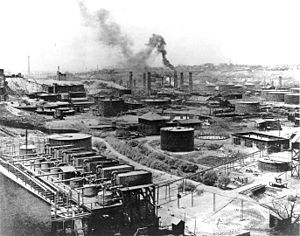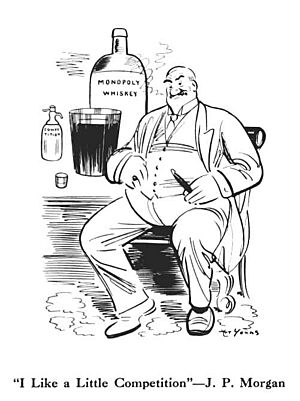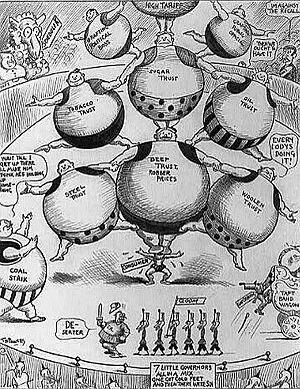History of United States antitrust law facts for kids
The history of United States antitrust law is about making sure businesses compete fairly. It started with the Sherman Antitrust Act in 1890. Before that, there were some rules about competition, but the Sherman Act was the first big federal law.
The word "trust" used to mean a legal arrangement, but people started using it to describe very large companies. These big companies, often called "big business," grew quickly in the 1880s and 1890s. Laws like the Interstate Commerce Act of 1887 began to shift control of big businesses from states to the federal government. Other important laws include the Clayton Antitrust Act and the Federal Trade Commission Act of 1914, the Robinson-Patman Act of 1936, and the Celler-Kefauver Act of 1950.

Contents
Early Rules for Business
Even before the Sherman Act, there were some basic rules about trade. These rules, part of what's called "common law," tried to stop people from unfairly limiting trade. For example, agreements that stopped someone from doing business were often not allowed.
Late 1800s: The Rise of Big Companies
In the late 1800s, many small railroad companies were bought up and combined into huge systems. This led to concerns about too much power in the hands of a few companies. People who supported strong antitrust laws believed that for America's economy to work well, there needed to be free competition. This would give everyone a chance to start and grow their own businesses.
Senator John Sherman famously said that if Americans wouldn't accept a king in politics, they shouldn't accept a "king" controlling important goods like food or transportation. Because of these concerns, Congress passed the Sherman Antitrust Act in 1890. This law made it illegal to try to limit trade or to form a monopoly. A monopoly is when one company controls almost all of a certain product or service. The Act gave the Justice Department the power to go to court to stop illegal business actions.
The Progressive Era: 1890s-1917
During the Progressive Era, many people were upset with large companies, especially Standard Oil. This company was seen as having too much control over the oil business. States tried to limit Standard Oil's power, but it was federal action that finally made a big difference.
In 1911, the government successfully broke up Standard Oil into 33 smaller companies. Even though they were separate, these companies often didn't compete much with each other. After this, and with the passing of the Clayton Antitrust Act of 1914 and the creation of the Federal Trade Commission (FTC) that same year, people felt less worried about "trusts."
Presidents Fight Trusts
Presidents during the Progressive Era made fighting trusts a top priority. President Theodore Roosevelt sued 45 companies under the Sherman Act. His successor, President William Howard Taft, sued even more, taking 75 companies to court.
For example, in 1902, Roosevelt stopped the creation of the Northern Securities Company. This company was trying to control all transportation in the Northwest, which would have been a huge monopoly.
Roosevelt and Taft's Actions
Roosevelt's time as president saw 18 civil lawsuits and 26 criminal cases against trusts. Taft's four years were even busier, with 54 civil and 36 criminal lawsuits. Taft's government went after many major companies, including Standard Oil, American Tobacco, United States Steel, and General Electric. They also targeted companies involved in beef, lumber, and other products.
Taft's Attorney General, George W. Wickersham, led the most important cases. He argued that trusts should be broken up because they didn't become powerful through fair business methods. The Supreme Court agreed in 1911 and ordered the breakup of Standard Oil and American Tobacco.
The Impact of Breaking Up Trusts
Many people hoped that breaking up these large companies would lower prices for consumers. However, after Standard Oil was broken up, prices for oil products actually went up. This happened because the new, smaller companies lost the efficiency that came with being a very large organization. For example, where one large company used to handle advertising and sales efficiently, now many smaller companies had to do it, which cost more. This showed that sometimes, being big could lead to lower prices for consumers due to efficiency.
The Standard Oil Story
John D. Rockefeller built the Standard Oil Company into a huge business in the 1870s and 1880s. He did this by making deals with railroads and using his economic power against competitors. In 1911, the Supreme Court ruled that Standard Oil had violated the Sherman Act.
The Court ordered the Justice Department to break up the monopoly. Standard Oil was split into over three dozen separate companies. These included companies that later became ExxonMobil, Amoco, and Chevron. When the Supreme Court approved the breakup, it added the "rule of reason." This rule meant that not all big companies or monopolies are bad. The courts would decide if a trust was harmful by seeing if it damaged fair competition.
Clayton Act Reforms

In 1914, Congress passed the Clayton Antitrust Act. This law made it easier for the government to step in and break up big businesses. It also made sure that antitrust laws did not apply to trade unions. The Act also put controls on how companies could merge with each other.
One problem with the Sherman Act was that it wasn't always clear what business actions were illegal. This made it hard for businesses to know what they could or couldn't do. The Clayton Act tried to fix this by specifically banning certain actions, like price discrimination (charging different prices to different buyers) and tying (making a customer buy one product to get another). These actions were illegal if they significantly reduced competition.
At the same time, Congress created the Federal Trade Commission (FTC). The FTC had experts who could work with businesses to reach "consent decrees." These were agreements that helped enforce antitrust rules without always going to court.
After the Progressive Era, people became less hostile towards big businesses. For example, Ford Motor Company became very successful by making millions of affordable cars. Ford lowered prices, paid good wages, and made manufacturing more efficient. Companies like Ford showed that big businesses could also benefit consumers and the economy. This led to less talk about "trust busting." In the 1920s, the government, under Herbert Hoover, even encouraged businesses to work together and made the FTC an ally of "respectable business."
The New Deal Era
During the New Deal in the 1930s, there were new attempts to control competition. The National Industrial Recovery Act (NIRA) tried to strengthen trade groups and raise prices, profits, and wages. The Robinson-Patman Act of 1936 aimed to protect small local stores from larger, more efficient chain stores by making it illegal to offer big discounts. Instead of breaking up companies, New Deal leaders often preferred to regulate them, like controlling the prices and services of American Telephone & Telegraph Company (AT&T).
The Supreme Court began to see antitrust laws as a "charter of freedom" for American businesses. Justice Douglas, for example, believed that these laws were not just about protecting consumers. They were also about stopping powerful companies from controlling the marketplace too much. He argued that too much power in a few hands could be dangerous for the economy and society.
After World War Two
By the 1970s, the focus shifted. People became confident that a truly competitive market would benefit everyone. The main fear was that monopolies would lead to higher prices, less production, inefficiency, and less prosperity. As labor unions became less powerful, the government paid more attention to how unfair competition could harm consumers, especially through higher prices, poorer service, and fewer choices.
In 1982, the huge breakup of the Bell System happened. AT&T was split into one long-distance company and seven regional "Baby Bells." The idea was that competition would be better for consumers and the economy than one large monopoly.
In the 1990s, companies started buying each other up more quickly. However, if a large company wanted to buy another, it first needed approval from the FTC or the Justice Department. Often, the government would require the new company to sell off some parts of its business to prevent it from having too much control in a specific market.
The 21st Century
In 1999, a group of 19 states and the federal Justice Department sued Microsoft. A well-known trial found that Microsoft had used its power to try and stop competition from the Netscape web browser. In 2000, the court initially ordered Microsoft to be split into two companies. However, a higher court reversed this decision.
Later, Microsoft and the government reached an agreement. The government dropped the case, and Microsoft agreed to stop many of the practices that were challenged. During his defense, Microsoft CEO Bill Gates argued that the company always worked to benefit consumers. He said that splitting the company would make it less efficient and slow down the creation of new software.
See also
- US antitrust law
- US labor law history
- EU competition law


